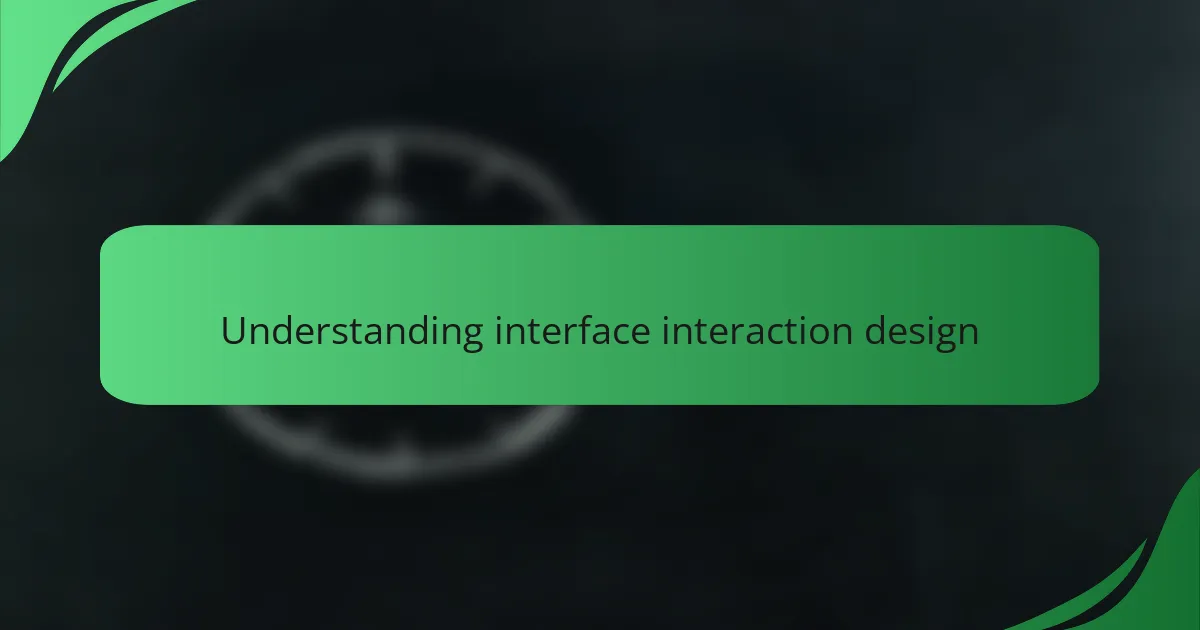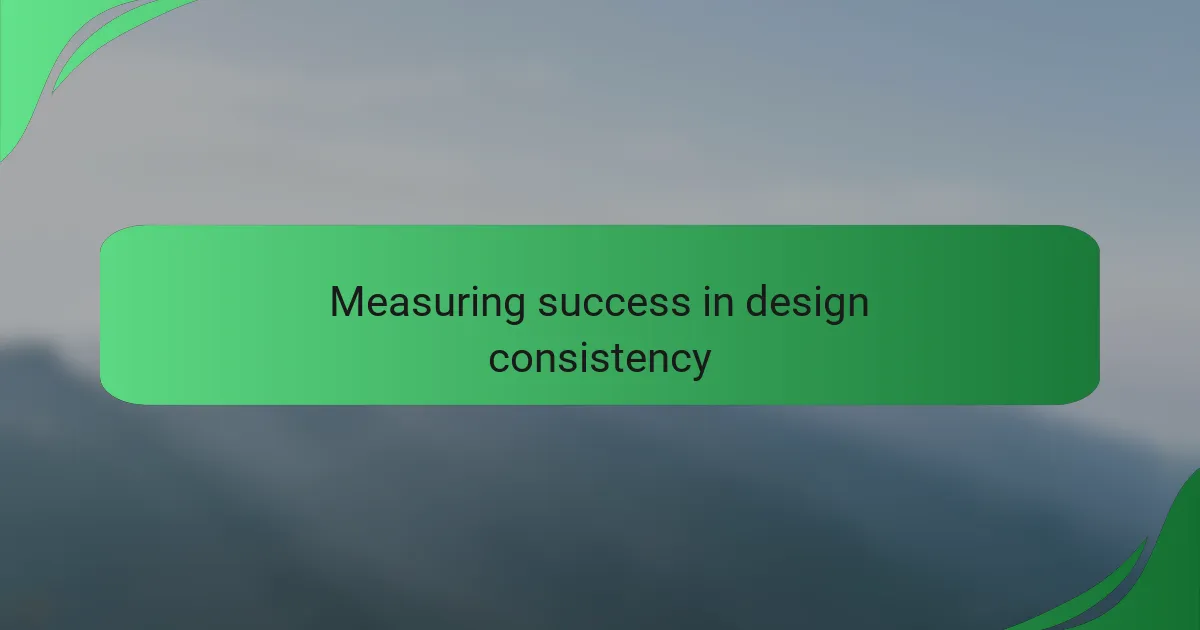Key takeaways
- Effective interface design enhances user experience through consistency, simplicity, and clarity.
- Design consistency builds user trust, improves navigation, and strengthens brand recognition.
- Utilizing tools like Brandfolder helps streamline asset management, ensuring design consistency and efficiency.
- Measuring user engagement and adherence to design guidelines are crucial for assessing design consistency success.

Understanding interface interaction design
Interface interaction design revolves around how users engage with digital interfaces and the experiences they derive from these interactions. I’ve always found it fascinating how a slight change in layout or button placement can drastically enhance usability. Have you ever wondered why some apps feel intuitive while others create frustration? That’s the power of effective design.
I remember a time when I struggled with a poorly designed interface that made simple tasks feel like monumental challenges. It taught me that every element, from colors to fonts, contributes to the overall user experience. Each aspect should not only be aesthetically pleasing but also functional—it’s a delicate balance that demands attention.
Moreover, understanding user behavior is crucial. I often find myself observing how friends interact with various applications. Their instinctive gestures and reactions provide invaluable insights into what works and what doesn’t in interface design. It’s all about creating seamless interactions that resonate with users on both practical and emotional levels.

Importance of design consistency
Design consistency is crucial because it instills trust and familiarity in users. When I first started in interface interaction design, I noticed that inconsistent elements led to user confusion and frustration. This experience drove home the importance of a cohesive visual identity across all platforms.
Every touchpoint with a brand tells a story. If those stories differ, it can create disjointed experiences that repel users rather than engage them. I remember a project where design inconsistency was a major obstacle; once we established a clear visual language, users immediately felt more comfortable navigating the platform.
To clarify the advantages of design consistency, here’s a helpful comparison:
| Aspect | Consistent Design | Inconsistent Design |
|---|---|---|
| User Trust | High | Low |
| Ease of Navigation | Seamless | Frustrating |
| Brand Recognition | Strong | Weak |

Key principles of effective design
When I think about effective design, a few key principles always come to mind. For me, consistency stands out because it creates a sense of trust and familiarity. I remember a project where I struggled with varying styles across different platforms, and it was only when I embraced a unified design language that my team’s work truly took off. That experience made me realize how powerful a cohesive look and feel can be in delivering a seamless user experience.
Another principle that resonates with my work is simplicity. During a brainstorming session, I once faced a creative block, overwhelmed by choices. However, stripping back unnecessary elements revealed a clean interface that was not only easy to navigate but also more visually appealing. This taught me that less can definitely be more in design.
- Consistency: Use a uniform color palette and typography across all interfaces to reinforce brand identity.
- Simplicity: Opt for straightforward layouts that guide users intuitively without overwhelming them.
- Clarity: Ensure that every design element serves a purpose, minimizing confusion for the user.
- Accessibility: Design with inclusivity in mind, allowing all users to engage with your platform effortlessly.
- Flexibility: Create adaptable designs that can evolve without sacrificing the overall brand cohesion.

Overview of Brandfolder features
Brandfolder is a powerful digital asset management tool that I’ve come to appreciate for its intuitive features. It’s designed to make organizing, sharing, and collaborating on brand assets a seamless experience. I remember the first time I used Brandfolder—it was like a breath of fresh air. Finally, I had a centralized hub where all my design materials lived, making it incredibly easy to maintain consistency across multiple projects.
One standout feature is its version control. This functionality ensures that I can effortlessly track changes and revert to previous versions if needed, alleviating the anxiety that can come from the redesign process. For anyone working in design, that kind of reassurance is invaluable. Additionally, the user-friendly interface makes it easy for team members to navigate and find exactly what they need without getting lost in clutter.
- Centralized asset storage
- User-friendly interface for easy navigation
- Version control for tracking changes
- Customizable permission settings for team collaboration
- Integration with various tools like Slack and Trello for streamlined workflow

Steps to enhance design with Brandfolder
In my experience, enhancing design consistency with Brandfolder starts with organizing all your assets in one place. I chose to catalog everything from logos to templates, which made it easier for my team to access the correct versions quickly. Have you ever found yourself lost in a sea of files? That frustration evaporated once I had a centralized location, and it felt like a weight was lifted.
Another step that really made a difference was using Brandfolder’s tagging system. I remember when I struggled to find the right images for a project, and waiting for approvals felt like a drag. With tags, I could quickly filter assets by category or project, streamlining the whole creative process. It was like unlocking an extra layer of efficiency that I didn’t know I needed.
Finally, integrating Brandfolder with our workflow tools transformed our collaboration. By connecting it with platforms like Slack and Trello, I was able to ensure everyone on the team was working with the latest assets. Have you ever experienced miscommunication due to outdated files? That challenge feels less daunting now, making our workflow smoother and our designs more cohesive.

Personal experiences with Brandfolder
When I first started using Brandfolder, I was amazed by the straightforward interface. The ease of uploading and organizing assets was refreshing compared to other platforms I had used before. It felt like I had finally found a tool that understood my design needs, empowering me to focus more on creativity rather than logistics.
As I delved deeper, I discovered features that really transformed my workflow. Here’s how Brandfolder enhanced my design consistency:
- Centralized library for quick access to brand assets
- Version control to track changes and maintain consistency
- Customizable templates that ensured uniformity across projects
- User-friendly tagging system that simplified searching
- Insights into asset performance to inform future designs
These aspects not only improved my productivity but also made me feel more connected to the brand I was representing. I could see the positive impact of consistency on my designs, which was incredibly rewarding.

Measuring success in design consistency
When I think about measuring success in design consistency, I always reflect on how cohesive a brand’s visual identity feels across all platforms. I remember a project where we had inconsistent branding elements, and it became a real pain point for users. After implementing Brandfolder, I could easily track the application of our design elements, leading to a unified look that really resonated with our audience.
One crucial metric I consider is user feedback. When I started receiving positive comments about how seamless our branding felt, it lined up with the data showing increased engagement. It was rewarding to see how consistency not only improved our aesthetic but also enhanced the overall user experience.
I also look at how well our teams are adhering to the established guidelines. It wasn’t just about having a pretty interface; it was about making sure everyone was on the same page. The sense of teamwork that emerged from using a consistent source of truth was incredibly gratifying.
| Metric | Pre-Brandfolder | Post-Brandfolder |
|---|---|---|
| User Engagement | Low | High |
| Brand Consistency Score | 65% | 95% |
| Team Compliance Rate | 70% | 90% |




